|
April 4, 2016: I had the chance to visit the Nippon Maru,
now stationary museum in Yokohama, near Tokyo, Japan.
Full View
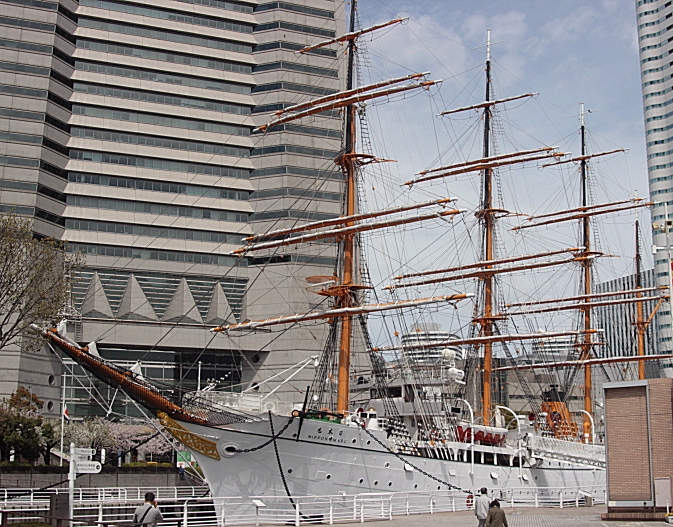
|
The 4-masted barque Nippon Maru (Nippon, or today Nihon, is how the Japanese call their own country, and Maru is how they call all their ships), is a memorial ship since 1984.
Despite going no more sailing, she is kept in good shape and even sets sails sometimes, and tourists come to admire her.
These pictures shall not be a replacement for a real visit to the ship, that I recommend very much indeed!
I had only 2 hours to be there, but I made about 800 photos for my ship modelling studies. And when I could not go onboard (it was monday when they keep closed!), I could ask a Japanese maintenance sailor to make some pictures for me, all that I cannot see from the outside; indeed he made 25 pictures for me! Arigatou gozaimashita!!
Now I present the best of them here:
|
The Hull and The Sides
The hull is fully white, with a thin black band, a classic color for training sailing ships.
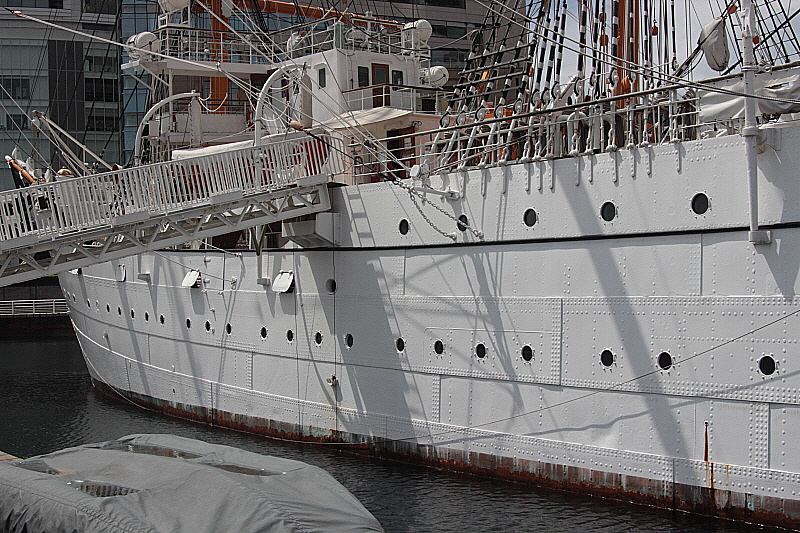
The Bow
The ornaments are in dark yellow, imitating gold, which would be too expensive ...
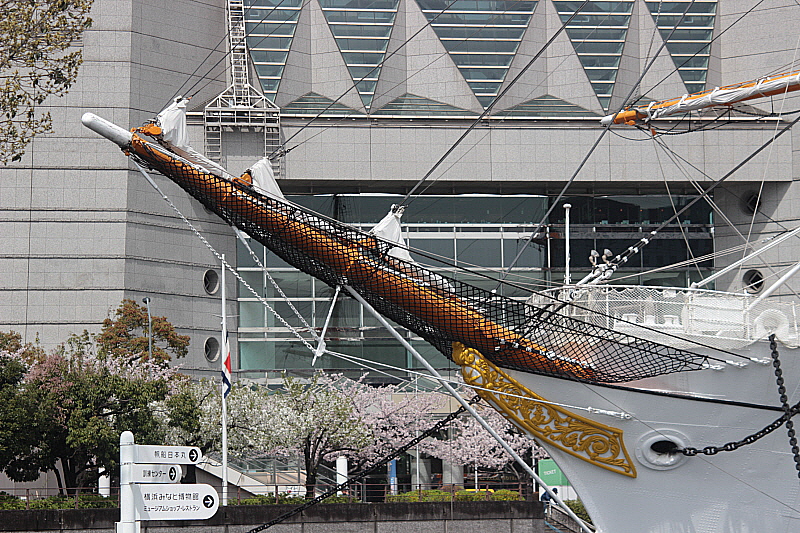
The Name is written in 3 black Japanese Characters: Ni-Hon-Maru, read from right to left(!).
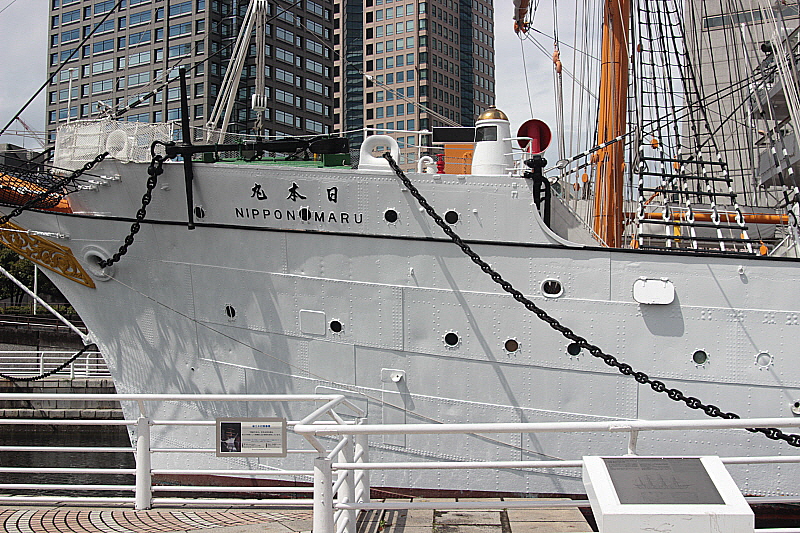
The Stern
The port name is written in 2 Japanese Characters below the name: Yoko-Hama, also read from right to left(!).
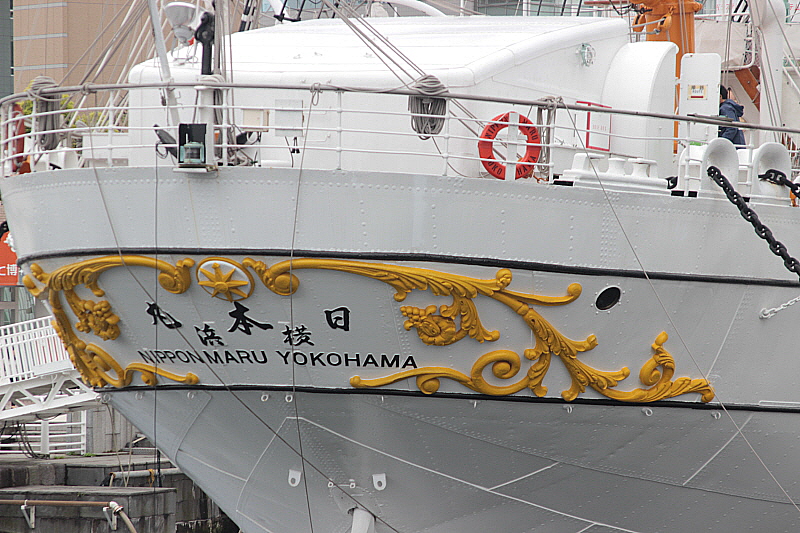
Forecastle and Bowsprit
The classic layout of the "monkey rail" for the staysail downhauls, a crane for anchor fishing, a capstan and the mooring bitts. To both sides, the storages for the anchors:
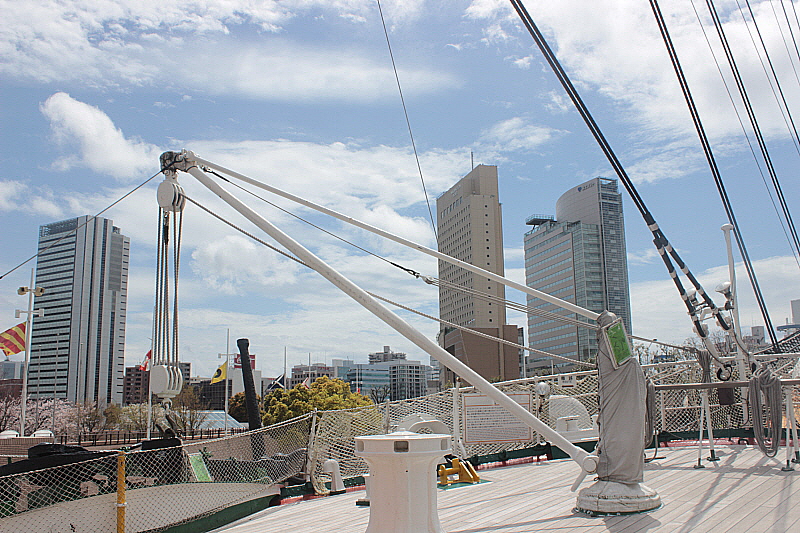
2 safety nets are fixed to the bowsprit
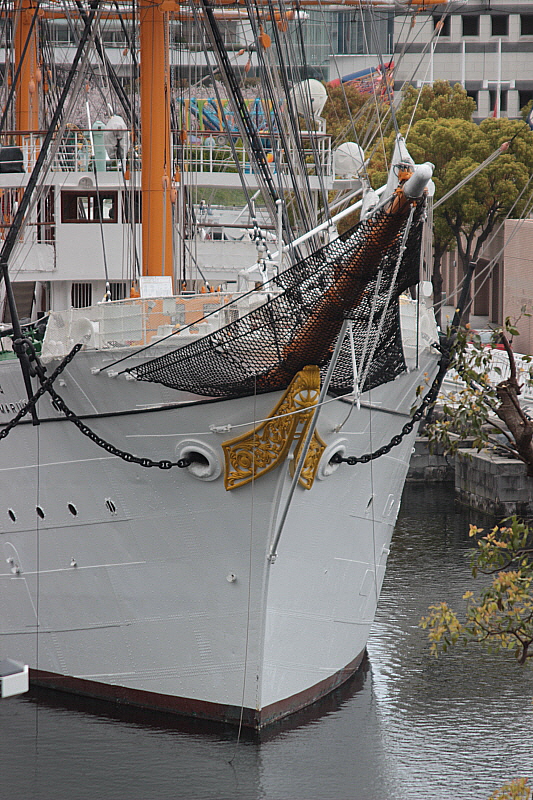
2 anchors are stored symmetrically to both sides
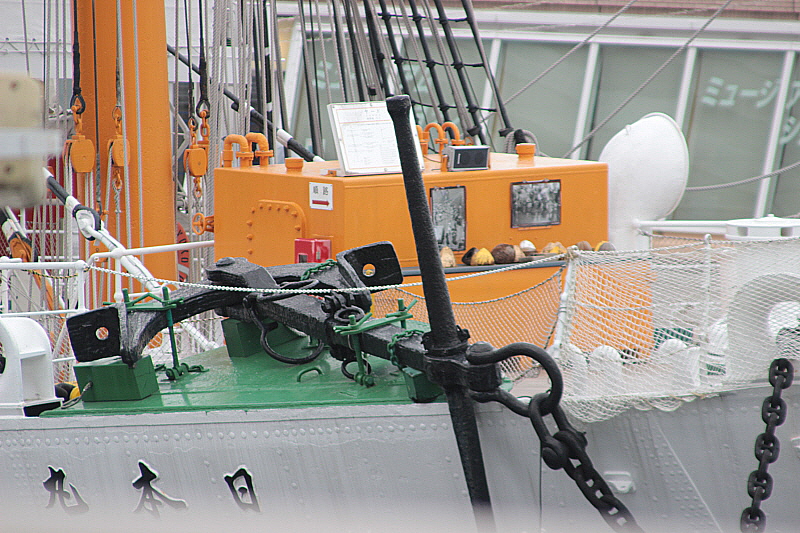
Same way, 2 auxiliary anchors are stored behind the forecastle:
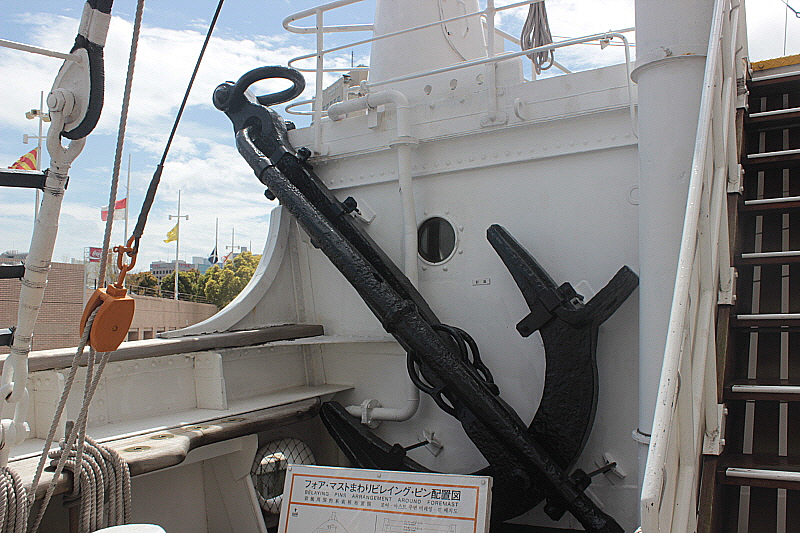
Fore Mast on the Fore Hut
This is the only mast standing lower than all other masts on the Long Quarter Deck, and the short opening is there only for a cargo hatch. The Russian "Sedov" has a similar layout, just the "Cargo Hatch Deck" here is indeed pretty short, and there is one gangway over it, but on starboard only, between Quarter Deck and Forecastle.
Just behind the Fore Mast, the steerman hut stands as the highest superstructure of the ship, and to both sides, the first pair of 6 lifeboats are stored:
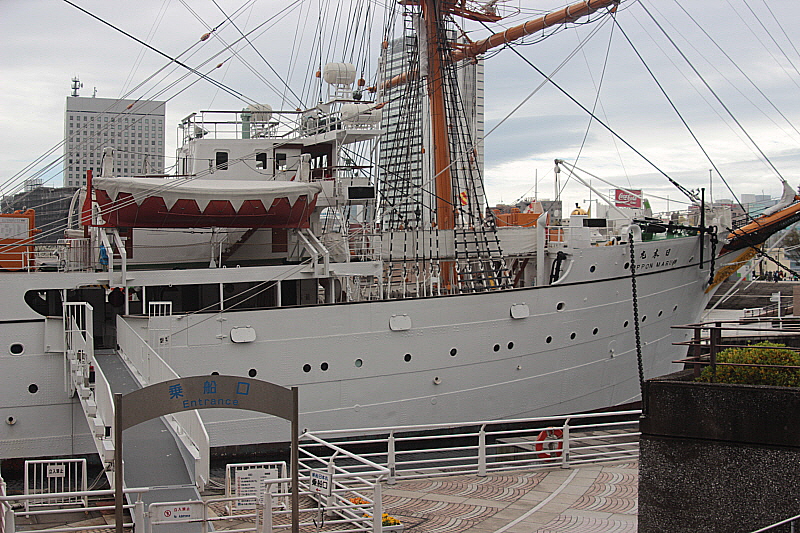
The fiferails around the Fore Mast foot show a classic layout of belaying positions (with some slight variations, of course) for the squaresail sheets and the topping lift. This system is "copy-paste" for the main and mizzen mast as well ...
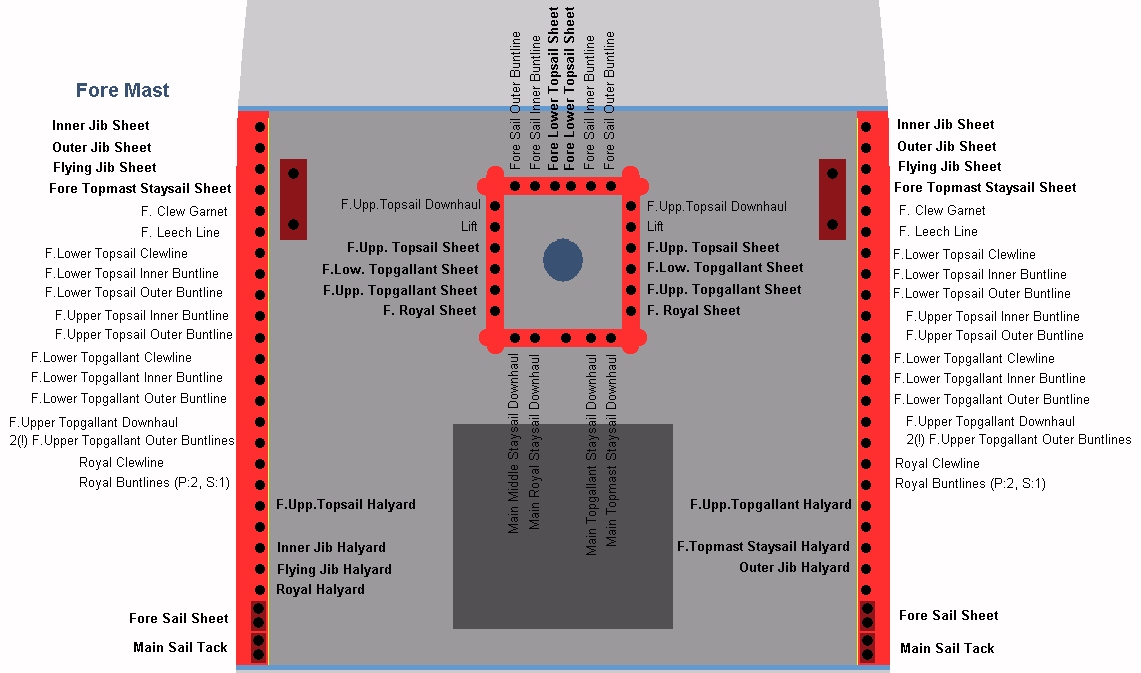
What is remarkable about these fiferails: look how they are attached over each other!
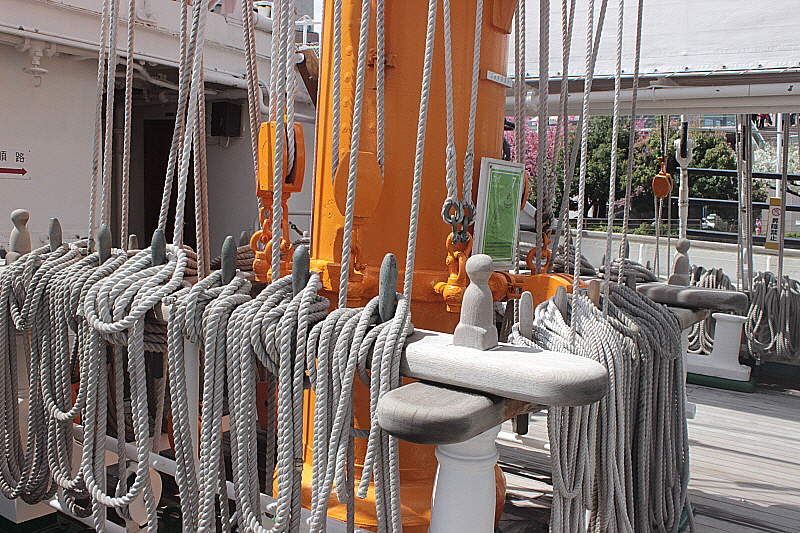
The long pinrails to both sides also share the same classic layout for the furling lines and halyards:
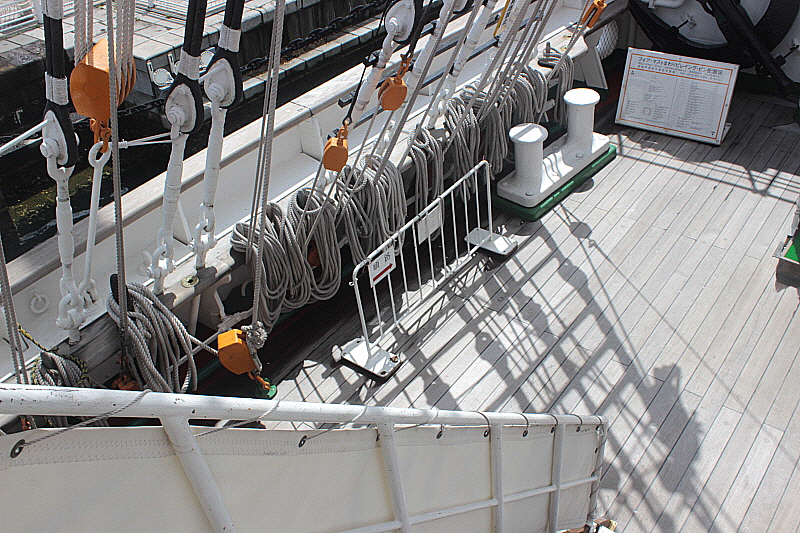
Square Sail Mast Details
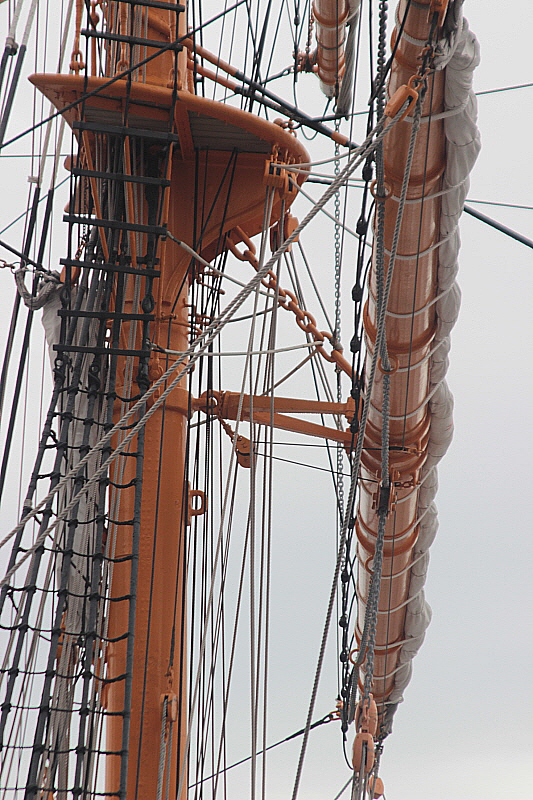
|
The first 3 masts (Fore, Main and Mizzen, as they named it on the Nippon Maru) have all the same classic windjammer layout of 6 yards:
- Lower (other call it Course, 1st or lowest yard),
- Lower and Upper Topsail (2nd and 3rd yard),
- Lower and Upper Topgallant (4th and 5th yard),
- and Royal sail (6th yard).
The Japanese took the English names for all rigging parts and simply write them in Katakana characters, and so they are pronounced pretty much the same as original English, including the "short name" for Topgallant: "te-gan".
The lower mast is painted all orange, as all yards. These parts are all made of steel, not wood.
The Course or the Lower Yard hangs in a fixed rack below the first platform.
The Lower yard is the only yard having a pair of non-fixed topping lifts, that are trimmed for balance from the fiferail at the mast foot. Trimming that topping lift, it "propagates" its balance to the upper yards as well, through the sheets. This is done when the yards are "braced sharp", that is: swung around up to 70 degrees to sail "closed to the wind". Else, the lifts are - or should be - equally balanced. Some bosuns use much time for fine-trimming the sails, giving instructions to the crew how far to heave and hold the lifts, sheets and braces, and they are only satisfied when the whole trimming "looks good".
When in port, of course all sails "hang in their gears", sails are bent, and the yards are balanced and braced nicely abeam.
|
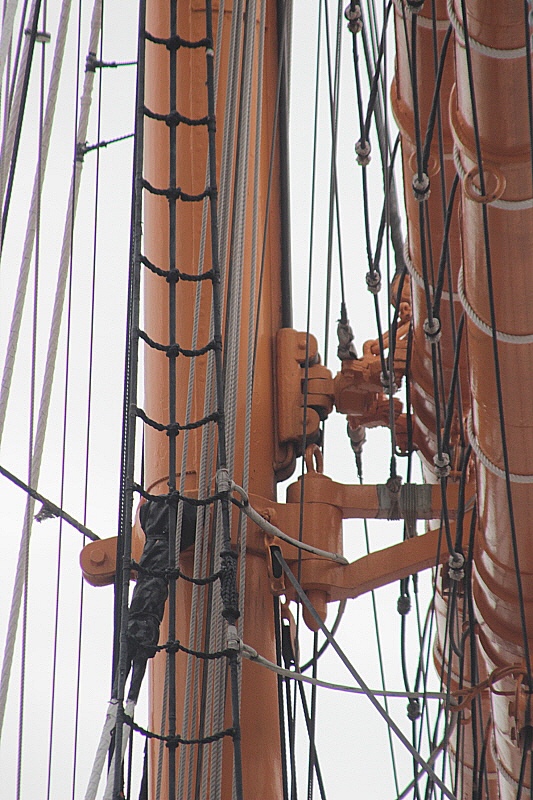
|
The 2nd yard, Lower Topsail, is also in a fixed rack.
Both fixed racks and gliding racks are made so that the yards can swing around up to 70 degrees to each side for "bracing" according to the course and wind directions.
The 3rd yard, Upper Topsail, is the first to be hoisted with a halyard (which derived from "haul-yard"), while its rack is gliding along a rail before the mast. The tackle to hoist this yard is the heaviest of all in the Running Rigging, if we neglect the anchors for a while ... the Upper Topsail Halyard consists of two 3-folded blocks, deviding the weight into 1/6; still it is too heavy for one person to hoist, and either at least 5 crewmembers heave it or they use a capstan for that.
The split into Lower and Upper Topsail is based on history: in the 1850s, the topsails had become so big that they were TOO big to handle, craving lots of heavy work up there. Dividing them in two solved that problem. Still there are very big.
The yard, including the sail attached, has a weight of up to 3 tons, and for a better balance, the hoistable yards are being lowered when the sail is not used, to avoid top-heaviness. And in the lowered positions, they "sit" on top of the fixed yards. Then You see Lower and Upper Topsail yards very closed together, in their "parking position" if You like:

The same system had been applied for the Lower and Upper Topgallants as well (4th and 5th yard), for the same reasons.
|
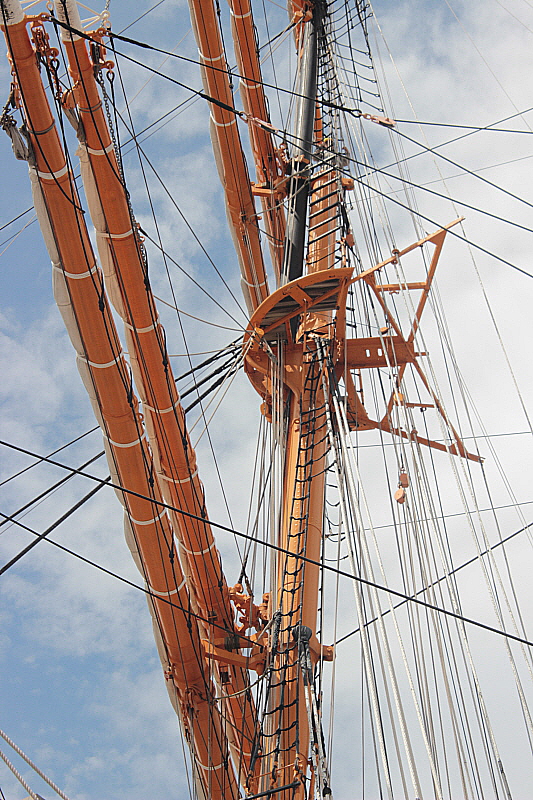
|
The lower mast (painted all orange) on windjammers often consists of one single steel pipe, combining the ancient topmast upon the lower mast. The topgallant mast (painted all black) is still attached to the lower mast/topmast as in history, with a second platform (the crosstrees, today of steel) and a mast cap. Stays to the fore and backstays to both sides are needed to stabilize the mast parts in that fixed position. In strong wind conditions, they still stretch the Standing Rigging a little but this is how they withstand the strain of the wind, which has incredible forces!
Modern Standing Rigging can only withstand these forces because they are made of steel wire. The ancient shrounds and backstays made of hemp where at least 5 times thicker and also much heavier.
The "shrouds" looking like spider webs have "ratlines" to step on, so they are used for "going aloft", climbing the mast. As the shrounds get too narrow the more You come above, the ratlines are extended to some backstays, to enable to step on to those. And in our modern times, there are extra safety lines on the shrouds, to which You hook in Your harness. The ancient sailormen had no safety at all ...
The lower yards and sails are the largest, heaviest and strongest sails made for storm weather.
The topgallant mast has the 3 uppest yards attached, those which are used in light weather only. On some windjammers, topgallant mast and its yards were made of wood (the Italian ship Amerigo Vespucci for example).
Lower and Upper Topgallant (4th and 5th yard) had been split for the same reason as the Lower and Upper Topsails: they were too big to handle as a single gigantic piece of heavy canvas.
The Royal sails (6th yard) are on big windjammers only, many ships had none. These smallest of all square sails are only used in fine weather, or in trading winds. Royals are also hoisted and lowered as needed, just there is no lower yard for them to "sit" on. On very tall ships, rarely, a 7th or even 8th yard was used, called "skyscraper" and "moon sail".
All yards that can be hoisted and lowered, hang "in their gears" when not used, that is: they have fixed "topping lifts" of steel wire, attached to the mast to balance them to both sides in that "parking position". Before the yard is hoisted, crewmembers sway out to the yard arms - up to 10 for each side! - to unbind the sails from the yards so that they hang in the buntlines only. Then they leave the yard, and hoist it from the deck. Then the fixed topping lifts hang loose before the sails like a longbow, and the balance of the yards is now enforced by the sheets instead.
|
And this is the right way how to go aloft: from outside up, not through the lubbers hole, which is only letting through the Running Rigging ... this was not me, it was one of the two Japanese maintenance sailors making pictures for me; I myself was not allowed onboard. But they understood perfectly what I wanted to see!

Main Mast and the Long Quarter/Poop Deck
This deck covers about 70% of the ship, and is filled with huts and the gears of 3 masts (Main/Mizzen/Jigger). Some deck space is only to port and starboard.
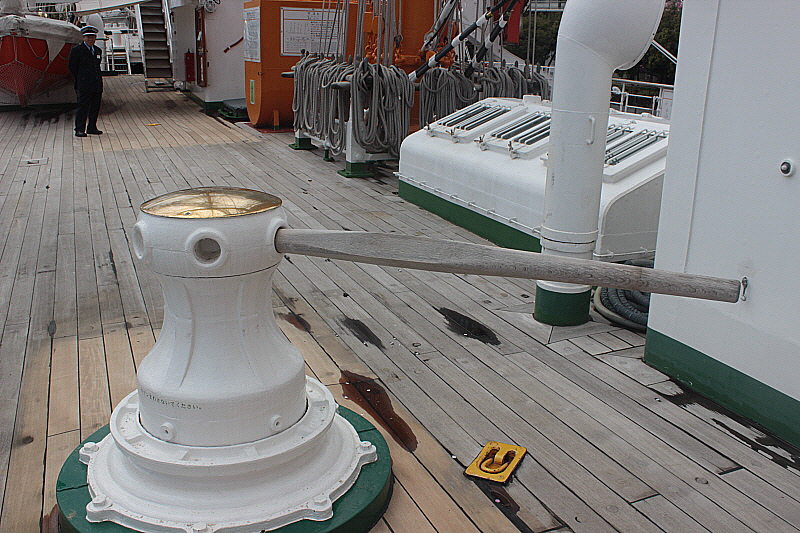
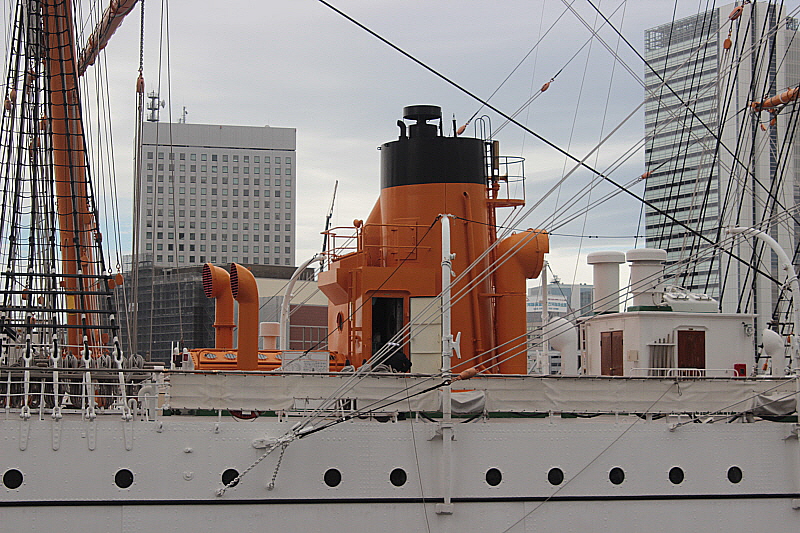

The long pinrails below each shroud are still fully operated with Running Rigging - a rare picture for a museum ship!

Jigger Mast (4th Mast)
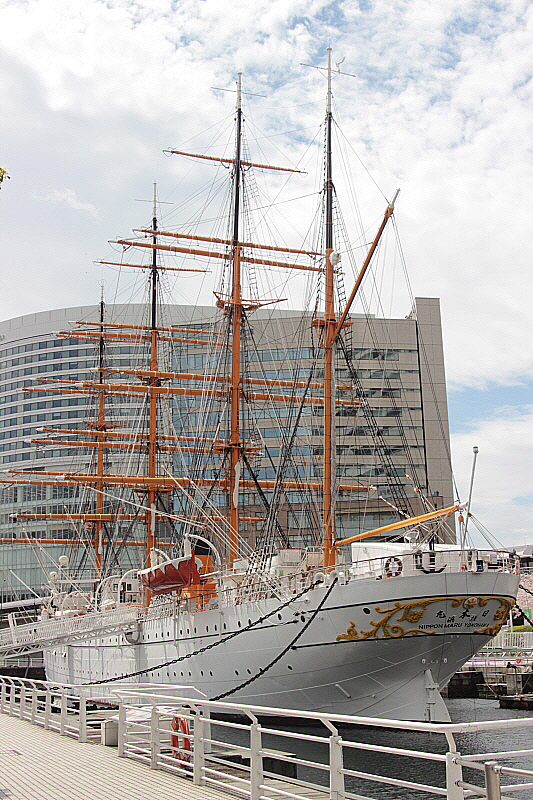
|
The jigger mast, as they named it on the Nippon Maru, the last mast onboard, is different from the other 3 square rigged masts. The Nippon Maru is a barque, not a "full rigger",
so the last mast has no square yards, but a gaff and a boom instead, for 2 fore-and-aft sails, called spanker and gaff topsail. The spanker is the largest of all sails.
It is interesting to see that the spanker and its gaff topsail are rarely being used, when wind comes from abeam, or in a reduced form, some make the spanker even triangular, obviously for easier handling. Often the jigger mast is completely idle, because it would give to much(!) drifting force for - or rather against - stable steering.
Below the spanker boom, which has 3 double-folded tackles, is an auxiliary, half-open steering hut with the classic wheel, which is only used when - the autopilot does not work ... as they cannot see anything from that position on deck, all steering commandos are still coming from the fore hut:
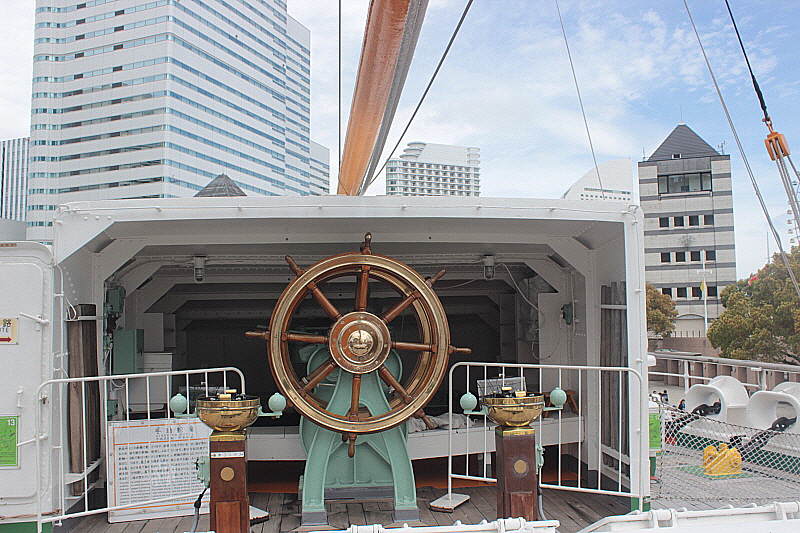
|
And these are only 21 pictures of 849 ...
The Complete Belaying Scheme
This is one of the utterly rare occasions to study history from originals =)
Compiled by me, using Japanese documents and my own pictures from Japan, in 2016 (click to zoom in):

The Japanese sailors actually use English terms for the entire rigging - so You will be able to read it!
Go and visit this ship, and see it with Your own eyes :)
Questions? Feel free:
j_gelbrich@gmx.net
|























